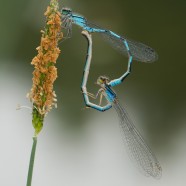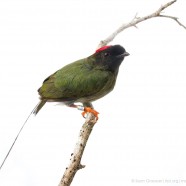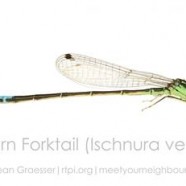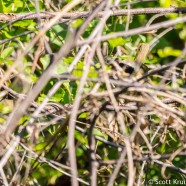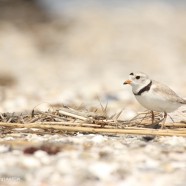Familiar Bluets
Here we have a pair of Familiar Bluet (Enallagma civile) damselflies in a “wheel”, a male and female joined together for mating. They are perched at a pond in this case but they can also fly this way. The male will likely remain with her until she lays the eggs. We are about to enter the prime flight time for our odonata – get out there to any local bodies of water to see what you can find. We will continue to survey for them across the Northeast to gain a greater knowledge of their distribution and abundance plus the health of our waterways.
Read MoreLong-tailed Manakin Aging
Sean was at the end of his trip in Costa Rica and wanted to do a series of the maturation of the Long-tailed Manakin (Chiroxiphia linearis) as they take over four years to reach full mature plumage. The full set will have to wait until next year when he captures more stages of the age maturation, but until then we can enjoy this second year male. It has a red cap, black face mask, and long tail feathers. It will soon get more of its adult body plumage, including the blue back patch. Photographed by RTPI Affiliate Sean Graesser for the Meet Your Neighbours global biodiversity project in Costa...
Read MoreEastern Forktails
One of the first spring damselflies to be seen, and one of our most abundant: The Eastern Forktail (Ischnura verticalis). As you can see the males and females can show a variety of coloration. Sean loves seeing fields and areas with water just filled with these jewels of all different colors. Photographed by RTPI Affiliate Sean Graesser for the Meet Your Neighbours global biodiversity project in Connecticut for the Roger Tory Peterson Institute of Natural History.
Read MoreCommon Yellowthroat
You can see me, but I can still see you, Common Yellowthroat (Geothlypis trichas) male. Keep working on that hiding game…especially in nesting season! Scott Kruitbosch Conservation & Outreach Coordinator
Read MorePiping Plovers Increasing
We have a lot of tiny Piping Plover hatchlings popping out on beaches across Connecticut right now, but we even have additional pairs and adult birds showing up on territories. These birds may have lost their nest somewhere else, or even a mate, and are searching for new prime real estate and other individuals who have not paired off. Sean took this photo of Milford Point’s eighth (!) pair of Piping Plovers! The entire coast of the town of Milford is one of the best Piping Plover areas in the state, and the birds certainly want to nest there, though there are only so many...
Read More



